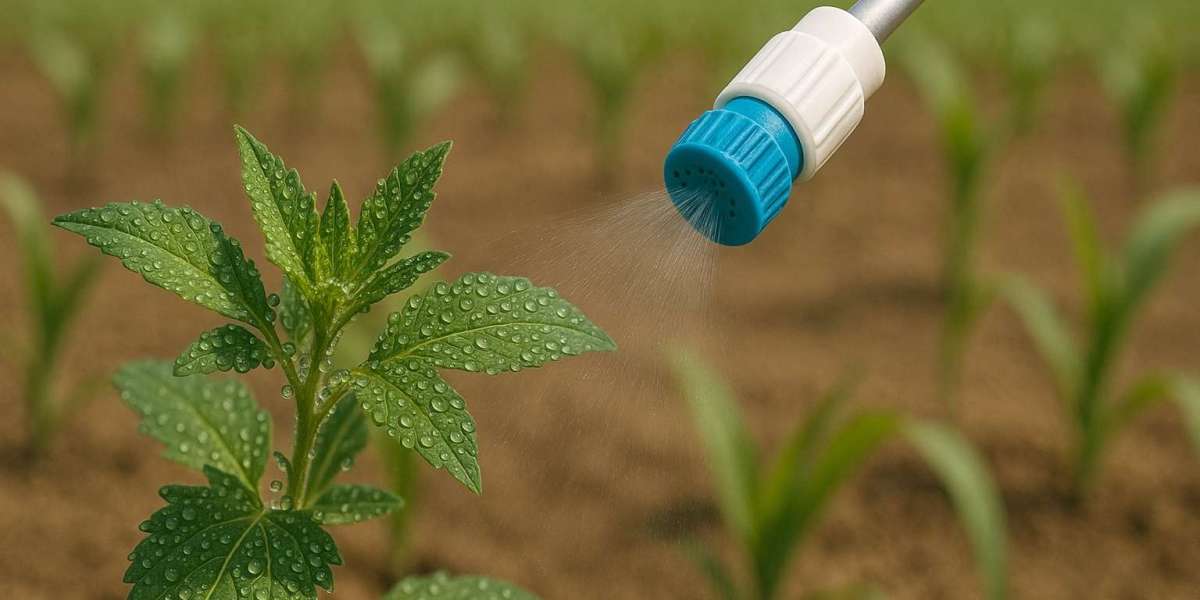Breaking Down the Role of Silicon Surfactants
A particular class of nonionic surfactants made from modified siloxanes are known as silicon surfactants, or organosilicone adjuvants. They have a super-spreading ability across plant surfaces because of their structure, which enables an ultra-low surface tension that is significantly lower than that of traditional surfactants.
This indicates that pesticides that are sprayed with a silicon surfactant adhere more tenaciously to even waxy or hairy leaves, disseminate more uniformly, and penetrate deeper. The droplets enter the leaf through stomatal apertures or microscopic pores and form a flat coating, rather than pooling or rolling off.
In contrast to conventional adjuvants, silicon-based formulations perform well in harsh environments, such as crops affected by drought or plants with hydrophobic leaf surfaces.
Enhancing Penetration and Efficacy of Pesticides
Farmers know that getting the pesticide onto the plant is just the first step. The real battle is getting it into the plant where it can act. That’s where silicon surfactants make their mark. Once applied, they reduce dynamic surface tension to such an extent that the pesticide solution can infiltrate stomatal pores within seconds.
A typical droplet treated with a silicon surfactant spreads up to 10 times faster than conventional formulations.
Absorption time for systemic pesticides can drop from hours to minutes.
This rapid penetration is especially valuable for time-sensitive applications, such as before an expected rain or in hot weather when stomata open wider. The result is greater pesticide activity, more consistent control, and fewer repeat applications.
Farmers using formulations designed for these outcomes often seek out reliable additives, and many choose to buy SuperSaver Spreader for its consistent performance across variable crops and pesticide types.
Addressing Spray Drift and Environmental Impact
Drift is a significant but little-discussed problem in pesticide application. Up to 50% of a spray may never reach its target due to factors like wind, nozzle design, and droplet behavior. Silicon surfactants assist droplets stay on target instead of evaporating in midair or dropping off-field by promoting adhesion and reducing droplet size variability.
This effectiveness lowers environmental contamination and public health hazards close to agricultural areas in addition to saving money. A key component of responsible pesticide use is droplet control, as stated in the EPA's pesticide drift guidelines. This standard is supported by the addition of silicon surfactants, which stabilize droplet adhesion and trajectory.
Synergy with Modern Application Technologies
Surfactants need to work with emerging technology as farms transition to automation and precision farming. Silicon surfactants work well together in robotic weed targeting, variable-rate applications, and drone spraying.
They are perfect for low-volume sprays, which are becoming more and more prevalent with precision instruments, because to their rapid-spread properties. The pesticide load is reduced but the effect is greater when each drop is optimized.
Tank-mix compatibility is also good, which lowers sedimentation and foaming. For farmers with mixed-input schedules and limited weather windows, that is crucial.
Pushing Boundaries in Biologicals and Biopesticides
Biopesticides, which are made from natural sources such as bacteria, fungi, or plant extracts, are becoming more and more popular. However, a lot of them suffer from inadequate leaf penetration or retention, which lowers their practical efficacy.
The solution to that issue is silicon surfactants. By improving contact with leaf surfaces, its ultra-spread technology enables even the most sensitive biopesticide formulations to function more effectively.
Additionally, silicon-based surfactants are chemically inert, maintaining microbial viability in contrast to other traditional adjuvants that can break down delicate biologicals.
When combined with an organosilicone surfactant, biopesticides' effectiveness against aphid populations increased by 23%, according to a 2023 Agricultural Research Council trial. Harvest schedules and market decisions can be affected by such a delta.
“Smart chemistry doesn’t just increase yield—it increases the odds of success in the field, where conditions rarely match textbook assumptions.”
Weather-Proofing Spray Applications
Extreme weather isn’t rare anymore—it’s the norm. Silicon surfactants offer a measure of protection by ensuring pesticide efficacy doesn’t rely entirely on ideal conditions.
In humid climates, faster stomatal penetration reduces wash-off risk from dew or sudden rain.
In dry areas, ultra-low surface tension helps penetrate waxy cuticles hardened by drought stress.
Their performance is less susceptible to spray timing and diurnal leaf behavior, giving farmers more flexibility in scheduling fieldwork.
Frequently Asked Questions
Do silicon surfactants work with all pesticide types?
Yes, they are compatible with most herbicides, insecticides, fungicides, and micronutrients. However, exact dosage should be adjusted based on formulation type and crop.Can overuse of silicon surfactants damage crops?
Yes. Overapplication can lead to phytotoxicity, especially on tender crops. Always follow label recommendations and consider conducting small-scale testing before applying the full field.Are there any concerns regarding storage or handling?
Most are stable in ambient conditions but should be kept sealed and away from sunlight. Always shake the container before use to ensure an even consistency.How do silicon surfactants differ from methylated seed oils (MSOs)?
MSOs improve cuticle penetration via oil-based carriers. Silicon surfactants achieve penetration through the reduction of surface tension and enhanced spreading. They’re often used for different purposes or in combination.What crops benefit most from silicon-based surfactants?
Crops with waxy leaves (such as cabbage, maize, or grapes), vertical leaf orientation (like wheat), or hairy surfaces (like tomatoes) exhibit the greatest response.
Cost-Effectiveness: Not Just for Big Farms
While silicon surfactants are favored in large-scale operations for cost savings, their benefits aren’t limited by acreage. Small and mid-size farms also gain:
Reduced need for second applications, saving labor.
Lower pesticide volumes without sacrificing performance.
Enhanced crop quality through improved pest and disease control.
Moreover, even high-value crops—like greenhouse ornamentals or berries—see a return on investment thanks to more uniform coverage and less phytotoxicity compared to older adjuvants.
Integrating into IPM Strategies
Integrated pest management, or IPM, is now a standard practice in many agricultural markets and is no longer optional. Silicon surfactants contribute to the effectiveness of IPM systems by increasing the accuracy and potency of each chemical application.
The lower quantities and better translocation that these adjuvants provide are advantageous to farmers operating under strict pest control thresholds or residue monitoring systems (particularly for export markets). In reality, resources such as the UC Agriculture and Natural Resources' IPM recommendations often emphasize the importance of adjuvants in achieving program objectives.
Future Trends: Where Silicon Surfactants Are Heading
What comes next? Innovation in surfactant design is trending toward dual-function molecules—those that can both distribute and protect, or provide nutrients alongside active substances. Others are being customized for nano-droplet sprayers and drone delivery systems.
To further customize the performance envelope, some developers are experimenting with programmable adjuvants that react to temperature or humidity.
In the meantime, regulatory bodies are beginning to distinguish between more recent silicon-based classes and older adjuvants, which may lead to safer labeling and simpler adoption.
What’s Really at Stake
The role of silicon surfactants in pesticide performance isn’t just about better sprays—it’s about better outcomes. Efficiency is key in a world where farmers must produce more with less—less water, less land, and less time.
In an unmanageable world, silicon surfactants provide control. They transform every droplet into an accurate instrument, every spray into an efficient delivery system, and every field pass into a calculated maneuver. Whether you're a row crop grower in Iowa, a tea farmer in Assam, or a tomato producer in Spain, the promise is the same: chemistry that works with the plant, not just on it.
This isn't about trends. In every tank mix, every growing season, and every acre that matters, trust is key.







